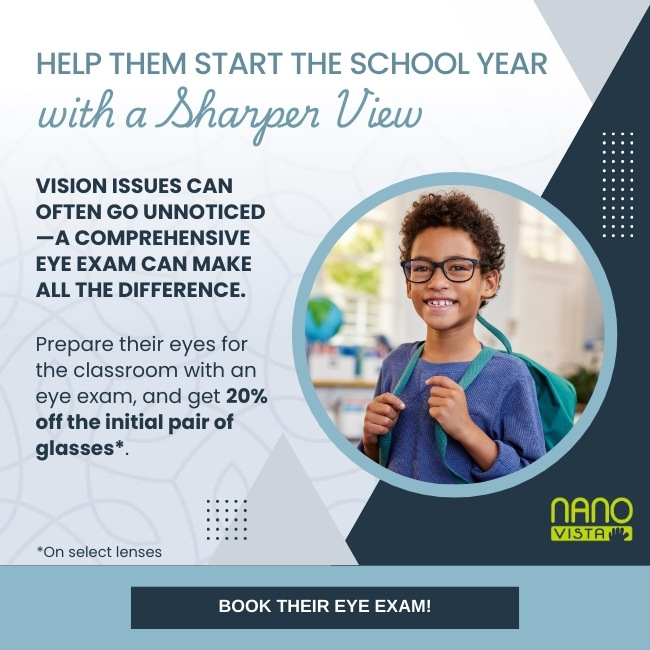Refractive errors are among the most common eye conditions worldwide, and they can cause problems such as blurry vision or strained eyes. Myopia (nearsightedness) and astigmatism are 2 common refractive errors affecting children or adults.
It’s not uncommon for myopia and astigmatism to occur together, but their only relation is that they are both refractive errors. Even the ways they physically affect or change the eye are slightly different.
If your vision is affected by one or both of these refractive errors, you may notice blurry vision or the need to squint to see clearly. But the only way to diagnose them is by an eye doctor during an eye examination. Once your optometrist determines what is causing your vision problems, they can recommend the best correction, like eyeglasses, contact lenses, or laser eye surgery.
What Is Myopia?
Myopia, also called nearsightedness, is a refractive error that causes blurry distance vision while nearby objects remain clear. An abnormal eyeball shape, such as being too long or the cornea having too much of a curve, is typically the cause. These abnormalities cause light not to focus properly.
Genetics can play a role in myopia development risk. Children whose parents have myopia have an increased risk of getting it themselves. Myopia control treatments can help slow the progression of the condition.
An estimated 30% of the population has myopia, and that is expected to become 50% by 2050, so it’s a common condition that your eye doctor may check during a children’s eye exam. Because early intervention can be the best chance at slowing myopic progression, many optometrists offer some form of myopia control.

What Is Astigmatism?
The cornea and eye’s lens are typically round when unaffected by any astigmatism. But many people have some degree of astigmatism, creating a more cylindrical cornea or lens shape. If someone has minor astigmatism, they may not notice any visual change.
Astigmatism can often develop early in life, so your eye doctor may check for it and myopia during a children’s eye exam. Astigmatism can also change throughout an adult’s life, which could result in a changing prescription.
Eye injuries or keratoconus can contribute to a person developing astigmatism, in addition to the genetic component.
How are Refractive Errors Diagnosed?
Depending on their severity, you may notice the symptoms of a refractive error, such as squinting to see, headaches, trouble focusing, or blurry vision at various distances. Your eye doctor can diagnose myopia or astigmatism during a comprehensive eye exam, even if you don’t notice any symptoms.
Your eye doctor can look at the surface and the inside of your eye using specialized equipment. They can also perform a visual acuity test as part of your eye exam. Another significant benefit of a comprehensive eye exam is catching other eye problems. In addition to looking for refractive errors, your eye doctor can check for other troublesome eye diseases and conditions.
Correcting Refractive Errors
There isn’t a “best” way to correct refractive errors. Each person’s overall eye health and unique situation plays a part in their optometrist’s treatment recommendations.
Eyeglasses
Prescription eyeglasses are often the most straightforward and safest way to treat a refractive error, such as myopia or astigmatism. Your optometrist can prescribe the right lenses based on their testing during an eye exam.
They may also recommend certain coatings or filters for the lenses based on your vision needs. For example, if you spend a lot of time on computers or using other digital devices, they may recommend a blue light filter in your lenses to help minimize your chance of developing digital eye strain.
Contact Lenses
Contact lenses may also be a correction option for many adults and responsible children. But there are certain risks, such as an increased chance of infection, eye irritation, or causing dry eyes.
But there are several types of contact lenses available that you can discuss with your eye doctor that may be suitable for your particular situation. For example, scleral lenses can be a good option for someone who has dry eyes.
Laser Eye Surgery
If neither contact lenses nor eyeglasses sound like something you want, laser eye surgery may be an option. Several types of laser eye surgery are available, each with its advantages and disadvantages. Some common requirements are a stable prescription, being over 18 years old, and having no untreated dry eye.
Not every eye doctor can offer laser eye surgery because it requires special training. But you may be able to discuss your options with your eye doctor. They can often give you a good idea of whether you’re a candidate for any procedure.
Discuss Your Correction Options with Your Eye Doctor
There are several ways to make your vision as clear as it can be. It’s a good idea to see your optometrist if you notice any signs in your vision that indicate a refractive error.
Call us at Doctors Eyecare Grande Prairie. Our professional team can answer your questions. And if it’s time to get your eyes checked, we can get you or your child in to see one of our optometrists for a comprehensive eye examination.




